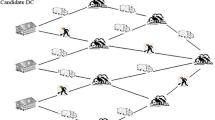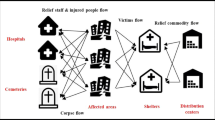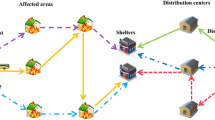Abstract
As natural disasters often cause catastrophic damages, disaster management must be considered. Relief logistics planning in disaster management is a dynamic process that includes deliberate processes taken before and after a disaster. This paper presents a robust optimization model for relief logistics planning covering before and after disaster actions to minimize the total cost. In this model, demand and traveling time between nodes are non-deterministic parameters, and scenario-based robust optimization is applied to handle uncertainty. The model is an integrated multi-echelon, multi-period, and multi-commodity vehicle routing problem considering the fair distribution of goods and services in a way that social costs are minimized. Vehicles can enter nodes and exit them several times. In this paper, a genetic algorithm (GA) is considered the solution approach. To estimate the GA parameters, an experimental design based on the Taguchi method is considered. A roulette wheel method is applied to select a child from parents for the next generation. Single-point crossover and swap mutation operators are used to generate the new child. Test problems in different scales are generated and solved using GAMS and GA. The results indicate that GA solutions have 3.75% gaps in average with optimal solutions. Finally, the model is applied with the data of a real case (Tehran). The results also indicate that it is better to consider the appropriate capacity for supply centers and distributors and select vehicles.








Similar content being viewed by others
Data availability
The data that support the findings of this study are available on request from the corresponding author. The data are not publicly available due to privacy/ethical restrictions.
References
Akbari F, Valizadeh J, Hafezalkotob A (2021) Robust cooperative planning of relief logistics operations under demand uncertainty: a case study on a possible earthquake in Tehran. Int J Syst Sci Oper Logist. https://doi.org/10.1080/23302674.2021.1914767
Altay N, Green WG III (2006) OR/MS research in disaster operations management. Eur J Oper Res 175(1):475–493
Altay N, Ramirez A (2010) Impact of disasters on firms in different sectors: implications for supply chains. J Supply Chain Manag 46(4):59–80
Balcik B, Bozkir CDC, Kundakcioglu OE (2016) A literature review on inventory management in humanitarian supply chains. Surv Oper Res Manag Sci 21(2):101–116
Banomyong R, Varadejsatitwong P, Oloruntoba R (2019) A systematic review of humanitarian operations, humanitarian logistics and humanitarian supply chain performance literature 2005 to 2016. Ann Oper Res 283:71–86
Besiou M, Pedraza-Martinez AJ, Van Wassenhove LN (2018) OR applied to humanitarian operations. Eur J Oper Res 269(2):397–405
Boostani A, Jolai F, Bozorgi-Amiri A (2021) Designing a sustainable humanitarian relief logistics model in pre-and postdisaster management. Int J Sustain Transp 15(8):604–620
Bozorgi-Amiri A, Akbari M, Dadashpour I (2022) A routing-allocation model for relief logistics with demand uncertainty: a genetic algorithm approach. J Ind Eng Manag Stud 8(2):93–110
Cao C, Li C, Yang Q, Liu Y, Qu T (2018) A novel multi-objective programming model of relief distribution for sustainable disaster supply chain in large-scale natural disasters. J Clean Prod 174:1422–1435
Caunhye AM, Nie X, Pokharel S (2012) Optimization models in emergency logistics: a literature review. Socioecon Plan Sci 46(1):4–13
Chang FS, Wu JS, Lee CN, Shen HC (2014) Greedy-search-based multi-objective genetic algorithm for emergency logistics scheduling. Expert Syst Appl 41(6):2947–2956
Chopra S, Meindl P (2007) Supply chain management. Strategy, planning & operation. In: Boersch C, Elschen R (eds) Das Summa Summarum des Management. Gabler, GWV Fachverlage GmbH, Wiesbaden, pp 265–275
Dantzig GB, Ramser JH (1959) The truck dispatching problem. Manag Sci 6(1):80–91
Daud MSM, Hussein MZSM, Nasir ME, Abdullah R, Kassim R, Suliman MS, Salu-din MR (2016) Humanitarian logistics and its challenges: the literature review. Int J Supply Chain Manag 5(3):107–110
Ding Z, Zhao Z, Liu D, Cao Y (2021) Multi-objective scheduling of relief logistics based on swarm intelligence algorithms and spatio-temporal traffic flow. J Saf Sci Resil 2(4):222–229
Eksioglu B, Volkan VA, Reisman A (2009) The vehicle routing problem: a taxonomic review. Comput Ind Eng 57(4):1472–1483
Ergün S, Usta P, Gök SZA, Weber GW (2021) A game theoretical approach to emergency logistics planning in natural disasters. Ann Oper Res. https://doi.org/10.1007/s10479-021-04099-9,ArticleinPress,1-14
Fahimnia B, Jabbarzadeh A, Ghavamifar A, Bell M (2017) Supply chain design for efficient and effective blood supply in disasters. Int J Prod Econ 183:700–709
Galindo G, Batta R (2013) Review of recent developments in OR/MS research in disaster operations management. Eur J Oper Res 230(2):201–211
Gharib Z, Bozorgi-Amiri A, Tavakkoli-Moghaddam R, Najafi E (2018) A cluster-based emergency vehicle routing problem in disaster with reliability. Sci Iran Trans E 25(4):2312–2330
Gökçe MA, Ercan E (2019) Multi-period vehicle routing & replenishment problem of neighbourhood disaster stations for pre-disaster humanitarian relief logistics. IFAC-PapersOnLine 52(13):2614–2619
Hasani A, Mokhtari H (2019) An integrated relief network design model under uncertainty: a case of Iran. Saf Sci 111:22–36
Hasanzadeh H, Bashiri M (2016) An efficient network for disaster management: model and solution. Appl Math Model 40(5–6):3688–3702
Holguín-Veras J, Pérez N, Jaller M, Van Wassenhove LN, Aros-Vera F (2013) On the appropriate objective function for post-disaster humanitarian logistics models. J Oper Manag 31(5):262–280
Holland JH (1975) Adaptation in natural and artificial systems: an introductory analysis with applications to biology, control, and artificial intelligence. University Michigan Press, Ann Arbor
Hoseininezhad F, Makui A, Tavakkoli-Moghaddam R (2021) Pre-positioning of a relief chain in humanitarian logistics under uncertainty in road accidents: a real-case study. S Afr Ind Eng 32(1):86–104
Hoyos MC, Morales RS, Akhavan-Tabatabaei R (2015) OR models with stochastic components in disaster operations management: a literature survey. Comput Ind Eng 82:183–197
Huang JS, Lien YN (2012) Challenges of emergency communication network for disaster response. In: Proceedings of the 2012 IEEE international conference on communication systems (ICCS). IEEE, pp 528–532
Jabbour CJC, Sobreiro VA, de Sousa Jabbour ABL, de Souza Campos LM, Mariano EB, Renwick DWS (2019) An analysis of the literature on humanitarian logistics and supply chain management: paving the way for future studies. Ann Oper Res 283:289–307
JICA C (2000) The study on seismic microzoning of the Greater Tehran Area in the Islamic Republic of Iran. In: Pacific consultants international report. OYO Cooperation, Japan, pp 291–390
JICA C (2006) The study on water supply system resistant to earthquakes in Tehran municipality in the Islamic Republic of Iran. In: Pacific consultants international report. OYO Cooperation, Japan, pp 1–415
Khayal D, Pradhananga R, Pokharel S, Mutlu F (2015) A model for planning locations of temporary distribution facilities for emergency response. Socioecon Plan Sci 52:22–30
Laporte G (1992) The vehicle routing problem: an overview of exact and approximate algorithms. Eur J Oper Res 59(3):345–358
Lei L, Lee K, Dong H (2016) A heuristic for emergency operations scheduling with lead times and tardiness penalties. Eur J Oper Res 250(3):726–736
Lenstra JK, Kan AR (1981) Complexity of vehicle routing and scheduling problems. Networks 11(2):221–227
Madani-Saatchi H, Arshadi-Khamseh A, Tavakkoli-Moghaddam R (2021) Solving a new bi-objective model for relief logistics in a humanitarian supply chain by bi-objective meta-heuristic algorithms. Sci Iran Trans E 28(5):2948–2971
Mamashli Z, Nayeri S, Tavakkoli-Moghaddam R, Sazvar Z, Javadian N (2021) Designing a sustainable-resilient disaster waste management system under hybrid uncertainty: a case study. Eng Appl Artif Intell 106, Article Number 104459
Mandal S, Patra N, Pal M (2021) Covering problem on fuzzy graphs and its application in disaster management system. Soft Comput 25(4):2545–2557
Memari P, Tavakkoli-Moghaddam R, Navazi F, Jolai F (2020) Air and ground ambulance location-allocation-routing problem for designing a temporary emergency management system after a disaster. Proc Inst Mech Eng Part H J Eng Med 234(8):812–828
Moheimani A, Sheikh R, Hosseini SMH, Sana SS (2021) Assessing the agility of hospitals in disaster management: application of interval type-2 fuzzy Flowsort inference system. Soft Comput 25(5):3955–3974
Mulvey JM, Ruszczyński A (1995) A new scenario decomposition method for large-scale stochastic optimization. Oper Res 43(3):477–490
Mulvey JM, Vanderbei RJ, Zenios SA (1995) Robust optimization of large-scale systems. Oper Res 43(2):264–281
National Governors’ Association Center for Policy Research (1979) Comprehensive emergency management: a governor’s guide. National Governors’ Association, Center for Policy Research, Washington
Nayeri S, Tavakkoli-Moghaddam R, Sazvar Z, Heydari J (2021) A heuristic-based simulated annealing algorithm for the scheduling of relief teams in natural disasters. Soft Comput. https://doi.org/10.1007/s00500-021-06425-6
Noham R, Tzur M (2018) Designing humanitarian supply chains by incorporating actual post-disaster decisions. Eur J Oper Res 265(3):1064–1077
Pérez-Rodríguez N, Holguín-Veras J (2015) Inventory-allocation distribution models for postdisaster humanitarian logistics with explicit consideration of deprivation costs. Transp Sci 50(4):1261–1285
Pradhananga R, Mutlu F, Pokharel S, Holguín-Veras J, Seth D (2016) An integrated resource allocation and distribution model for pre-disaster planning. Comput Ind Eng 91:229–238
Praneetpholkrang P, Kanjanawattana S (2021) A multi-objective optimization model for shelter location-allocation in response to humanitarian relief logistics. Asian J Shipp Logist 37(2):149–156
Red Crescent Society of Tehran (RCS) (2005) Preparedness program to deal with Tehran’s disasters by earthquake approach. Iranian Red Crescent Society (IRCS), Tehran
Rezaei-Malek M, Tavakkoli-Moghaddam R (2014) Robust humanitarian relief logistics network planning. Uncertain Supply Chain Manag 2(2):73–96
Rezaei-Malek M, Tavakkoli-Moghaddam R, Zahiri B, Bozorgi-Amiri A (2016) An interactive approach for designing a robust disaster relief logistics network with perishable commodities. Comput Ind Eng 94:201–215
Rezaei-Malek M, Torabi SA, Tavakkoli-Moghaddam R (2019) Prioritizing disaster-prone areas for large-scale earthquakes’ preparedness: methodology and application. Socioecon Plan Sci 67:9–25
Rivera-Royero D, Galindo G, Yie-Pinedo R (2016) A dynamic model for disaster response considering prioritized demand points. Socioecon Plan Sci 55:59–75
Rodríguez-Espíndola O, Albores P, Brewster C (2018) Disaster preparedness in humanitarian logistics: a collaborative approach for resource management in floods. Eur J Oper Res 264(3):978–993
Rottkemper B, Fischer K, Blecken A (2012) A transshipment model for distribution and inventory relocation under uncertainty in humanitarian operations. Socioecon Plan Sci 46(1):98–109
Sarma D, Das A, Bera UK (2020) An optimal redistribution plan considering aftermath disruption in disaster management. Soft Comput 24(1):65–82
Sinchi-Levi D, Kaminsky P, Simchi-Levi E (2000) Designing and managing the supply chain: concepts, strategies and case studies. Irwin MacGraw-Hill, Boston
Stepanov A, Smith JM (2009) Multi-objective evacuation routing in transportation networks. Eur J Oper Res 198(2):435–446
Stevenson WJ, Hojati M, Cao J (2014) Operations management. McGraw-Hill Education, New York
Tofighi S, Torabi SA, Mansouri SA (2016) Humanitarian logistics network design under mixed uncertainty. Eur J Oper Res 250(1):239–250
Torabi SA, Shokr I, Tofighi S, Heydari J (2018) Integrated relief pre-positioning and procurement planning in humanitarian supply chains. Transp Res Part E Logist Transp Rev 113:123–146
Toth P, Vigo D (2002) The vehicle routing problem. Society for Industrial and Applied Mathematics (SIAM), Philadelphia
Xiang Y, Zhuang J (2016) A medical resource allocation model for serving emergency victims with deteriorating health conditions. Ann Oper Res 236(1):177–196
Yi W, Özdamar L (2007) A dynamic logistics coordination model for evacuation and support in disaster response activities. Eur J Oper Res 179(3):1177–1193
Yu CS, Li HL (2000) A robust optimization model for stochastic logistic problems. Int J Prod Econ 64(1–3):385–397
Zahiri B, Pishvaee MS (2017) Blood supply chain network design considering blood group compatibility under uncertainty. Int J Prod Res 55(7):2013–2033
Zahiri B, Torabi SA, Tavakkoli-Moghaddam R (2017) A novel multi-stage possibilistic stochastic programming approach with an application in relief distribution planning. Inf Sci 385(225–249):2017
Zhan SL, Liu S, Ignatius J, Chen D, Chan FT (2021) Disaster relief logistics under demand–supply incongruence environment: a sequential approach. Appl Math Model 89:592–609
Zhang J, Dong M, Chen FF (2013) A bottleneck Steiner tree based multi-objective location model and intelligent optimization of emergency logistics systems. Robot Comput Integr Manuf 29(3):48–55
Zhang P, Liu Y, Yang G, Zhang G (2020) A distributionally robust optimization model for designing humanitarian relief network with resource reallocation. Soft Comput 24:2749–2767
Acknowledgements
The authors would like to thank the Editor-in-Chief and autonomous reviewers for their helpful comments and suggestions, which greatly improved the presentation of this paper. Also, the support of the Iranian Operations Research Society is highly acknowledged by the third author, as the board member of this society.
Funding
There is no funding information applicable for this research.
Author information
Authors and Affiliations
Contributions
All authors (AA, ARK, RT-M, EN) have contributed to all parts of this research including formal analysis; conceptualization; writing—original draft; visualization; methodology; software; validation; data collection and investigation; and writing—review and editing. Also, RT-M has the role of supervision and project administration.
Corresponding author
Ethics declarations
Conflict of interest
The authors declare that there is no potential conflict of interest regarding the publication of this paper.
Ethical approval
The authors certify that they have no affiliation with or involvement with human participants or animals performed by any of the authors in any organization or entity with any financial or non-financial interest in the subject matter or materials discussed in this paper.
Additional information
Publisher's Note
Springer Nature remains neutral with regard to jurisdictional claims in published maps and institutional affiliations.
Rights and permissions
About this article
Cite this article
Aliakbari, A., Rashidi Komijan, A., Tavakkoli-Moghaddam, R. et al. A new robust optimization model for relief logistics planning under uncertainty: a real-case study. Soft Comput 26, 3883–3901 (2022). https://doi.org/10.1007/s00500-022-06823-4
Accepted:
Published:
Issue Date:
DOI: https://doi.org/10.1007/s00500-022-06823-4




